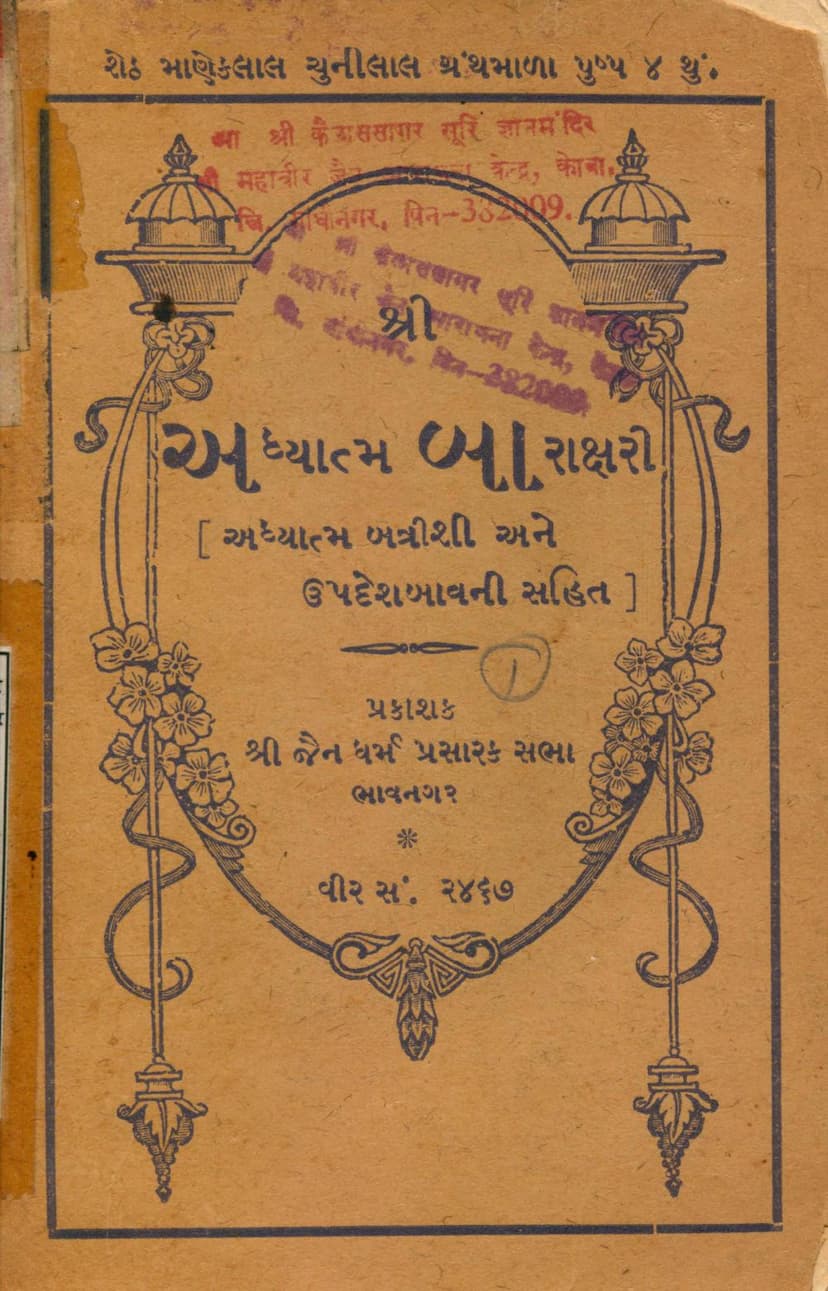Adhyatma Barakshari
Added to library: September 1, 2025

Summary
Here's a comprehensive summary of the Jain text "Adhyatma Barakshari," based on the provided pages:
Book Title: Adhyatma Barakshari (અધ્યાત્મ બારાક્ષરી) Author(s): Jain Dharm Prasarak Sabha (as publishers and compilers) Publisher: Jain Dharm Prasarak Sabha, Bhavnagar Catalog Link: https://jainqq.org/explore/032384/1
Overall Purpose and Structure:
"Adhyatma Barakshari" is a Jain spiritual compilation presented as the fourth volume in a series supported by Seth Maneklal Chunilal. The book aims to provide spiritual guidance and insight into the soul's journey towards liberation (moksha). It features three primary sections:
- Adhyatma Barakshari (અધ્યાત્મ બારાક્ષરી): This is the main body of the work, consisting of 437 dohas (couplets) structured around the Gujarati alphabet. The author has attempted to create dohas starting with each consonant (arranged in groups) and the vowels, with each starting letter having twelve dohas.
- Adhyatma Battriishi (અધ્યાત્મ બત્રીશી): This section comprises 32 dohas composed by Banarasidas.
- Upadesh Bhavani (ઉપદેશ બાવની): This section includes 62 savayyas (a type of verse) composed by the renowned Acharya Maharajshri Vijayanandsurishwarji (Atmaramji Maharaj).
Key Content and Themes:
The text primarily focuses on Adhyatma (અધ્યાત્મ), which translates to spiritualism, self-realization, and the pursuit of the soul's true nature. Across all sections, the recurring themes include:
- Detachment from the Worldly: The dohas emphasize the impermanence and illusory nature of the material world, including possessions, relationships, youth, and the body.
- The Soul's True Nature: The text guides readers to recognize the soul as eternal and distinct from the physical body and worldly attachments.
- The Cycle of Birth and Death (Samsara): It highlights the suffering inherent in the cycle of transmigration and the means to escape it.
- Spiritual Practices: Various practices are encouraged, such as meditation (dhyan), devotion (bhakti), chanting (jap), self-control (sanyam), detachment from senses, adherence to vows (vrat), and cultivating virtues like forgiveness (kshama), patience (samata), truthfulness (satya), and non-violence (ahimsa or jivadaya).
- The Importance of the Guru: The role of a spiritual guide (guru) is stressed as essential for understanding true knowledge and navigating the spiritual path.
- Virtues and Vices: The text contrasts virtuous actions and qualities with vices and their negative consequences.
- The Path to Moksha (Liberation): The ultimate goal is to achieve liberation from the cycle of birth and death, attain eternal peace, and realize the soul's inherent purity and oneness with the divine.
Details of Each Section:
-
Adhyatma Barakshari (The Alphabetical Dohas):
- Composition: The dohas are meticulously crafted, with each consonant (arranged into five groups, plus additional letters like Y, R, L, V, Sh, Sh, S, H, L, KSh) forming the beginning of twelve dohas. The twelve vowels also have twelve dohas each. The total number of dohas reaches 437.
- Linguistic Notes: The introduction mentions some specific linguistic usages and corrections made during the compilation, such as the use of 'J' instead of 'N' or 'B', and 'Satt' instead of 'J' for pronunciation and meaning.
- Author and Date: The author remains unnamed, reflecting a sense of humility. The composition date is noted as Samvat 1853 (1797 CE), Jeth Sudhi 3, Thursday.
- Content Focus: These dohas are particularly strong in describing the ephemeral nature of worldly existence and the suffering involved in the cycle of rebirth.
-
Adhyatma Battriishi (by Banarasidas):
- Source: Taken from a book titled "Sajjan Sanmitra."
- Content: It consists of 32 dohas focusing on spiritual themes, likely complementing the main section with similar messages of detachment and self-awareness.
-
Upadesh Bhavani (by Acharya Atmaramji Maharaj):
- Source: Compiled from the commentary on the Navatattva scripture.
- Content: This section contains 62 savayyas that expound spiritual advice. The introduction notes that while the Hindi-mixed language was retained, some minor corrections were made during printing for clarity. The publishers express a willingness to incorporate further corrections if sent.
- Themes: These verses delve into detailed spiritual practices and the principles of Jainism, often using numerical symbolism and enumerations of virtues and vows.
Compilation and Sponsorship:
The Jain Dharm Prasarak Sabha undertook the effort to rescue and publish the "Adhyatma Barakshari" by obtaining an old manuscript from Shah Amritlal Mavji of Thanadevali. They then printed it, adding explanations for difficult words. The publication was financially supported by Seth Maneklal Chunilal J.P. of Mumbai as the fourth flower in his "Granthmalana" (book series).
Value and Recommendation:
The book is recommended for those who are "Adhyatma Rasik" (keen on spirituality). The dohas of the Adhyatma Barakshari are praised for their clear explanation of the transient and hollow nature of worldly life. The compilation is considered a valuable and pleasing collection that provides beneficial teachings.
In essence, "Adhyatma Barakshari" is a compendium of spiritual wisdom from the Jain tradition, offering a structured approach through alphabetical verses and the teachings of revered saints to guide individuals towards self-realization and liberation.